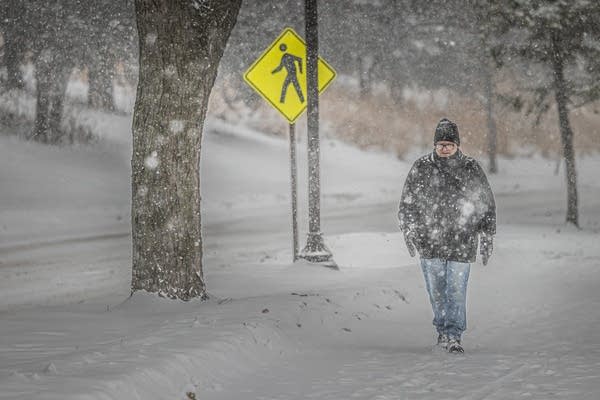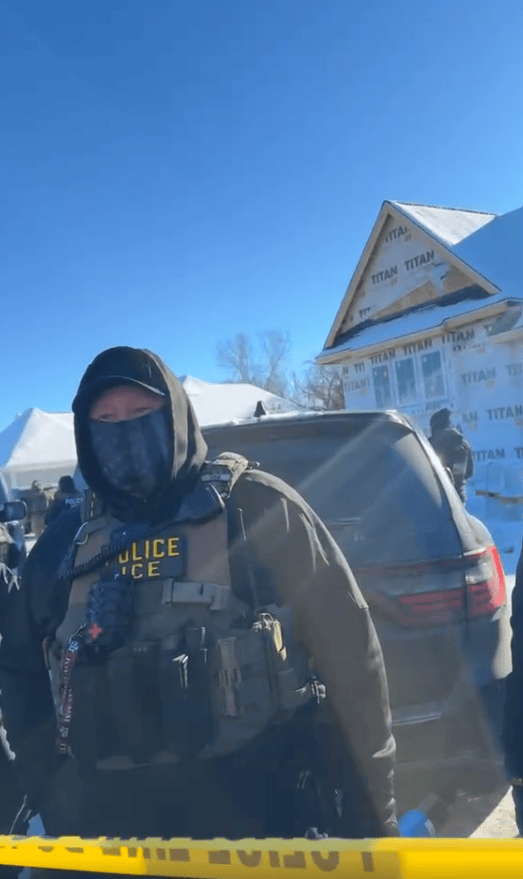(KNSI) — I’m guessing we all probably already know that firefighting is a tough job. Sunday, I got a tiny glimpse into just how tough it is.
KNSI was invited to Fire Ops 101 with the St. Cloud Fire Department. Fire Ops 101 provides elected and appointed officials and the media with a hands-on opportunity to better understand the complexities of what firefighters do daily. We were exposed to the smoke, the adrenaline rush, and the physical stress and strain firefighters and emergency medical personnel routinely address.
There were four exercises we took part in:
- Vehicle extrication
- Building search and rescue
- Cardiac arrest management
- A live-fire attack
They were all similar to firefighters’ training experiences when learning to become a firefighter; however, they were adapted for the regular people like me who don’t deal with those situations every day.
Before we suited up, We learned about just how busy the fire department is. 70% of the calls they go on are medical calls. Maybe that’s a car crash, or a broken arm, or a severe life-threatening injury. They also respond to respiratory issues, heart attacks, and an increasing number of mental health calls. In 2018, the St. Cloud Fire Department had 6,682 calls for service. In 2019, they had 6,883. In 2020 that number was up to 6,960, and as of 7:00 p.m. on Sunday, October 9th, it was 6,178. That means the St. Cloud Fire Department could see up to 8,000 calls for service this year.
According to the United States Fire Service Needs Assessment from the National Fire Protection Association, science-backed research shows that there must be four firefighters on a truck for a standard residential area. For a high call volume area, there must be five on the truck. In more densely populated urban areas, six on a truck.
According to the National Institute of Standards and Technology, when someone calls 911 for a house fire, there must be a minimum of 15 firefighters who respond. For a fire in an apartment building, it must be 28, and for a larger building, it must be 43. For the St. Cloud Fire Department, there are 20 firefighters on duty at any one time; plus, according to fire officials, the St. Cloud Fire Department has a strong mutual aid relationship with area agencies. That means if a fire is large enough and requires so much manpower that more firefighters than what are on duty need to respond, the St. Cloud Fire Department can call area agencies to cover other calls and help on a scene. The calls are covered for up to 8 hours without incurring any costs.
I also learned that roughly 90% of the time, the St. Cloud Fire Department can respond to a call within 4 minutes of being dispatched. With the swift pace of population growth, however, at least two more fire stations will be needed within the next several years to continue to make that four minute mark.
Why is this important?
Experts say fire doubles in size roughly every minute. That means if a fire has been burning for, let’s say, five minutes before a smoke detector goes off or a person inside is alerted to a fire, and it takes up to 2 minutes to call 911 and relay the information. Then it’s another 4 minutes before the fire department gets to your house. That means by the time the fire department shows up and comes in the door; a fire could be burning for over 10 minutes. According to Ready.gov, in two minutes, a fire can become life-threatening. In five minutes, a residence can be engulfed in flames.
Once classroom instruction finished, my group was suited up and headed over to vehicle extrication. We used a spreader, the jaws of life, and a saws-all. The spreader was used to open up a space so the jaws of life can cut apart pillars or cut off car doors. Sometimes, older tools are not strong enough or fast enough to get someone cut out of a car in a reasonable amount of time, so a saws-all is needed. Newer tools, many of which are battery operated, are stronger and faster, but new challenges arise. Vehicles now have reinforced pillars and are frequently harder to cut through. With the advent of electric cars, there’s so much voltage going through the car; it makes it more challenging to cut through for fear of electrocution, even after a battery is disconnected. Tesla models have markings specifically for fire departments, so they know where it is safe to cut through.
While firefighters are cutting apart the car, paramedics usually take vitals and speak with the patients doing what is known as patient care. Once the vehicle is cut apart, everyone works together to get the patients out of the vehicle and either into an ambulance and on their way to the hospital, into a helicopter on their way to a trauma center, or to the back of an ambulance to be checked out.
After we finished with vehicle extrication, we learned about building search and rescue.
The station we were at, station 2, has a training tower. The firefighters worked with us to get into the proper gear. That gear and other personal protective equipment consisted of a helmet, balaclava, breathing apparatus that resembled a gas mask that went over my entire face, a turnout coat, turnout pants with suspenders, gloves, thick-soled steel-toed boots, a full oxygen tank, and a personal alert safety system. All told, it weighs around 50 to 60 pounds. It took me a few minutes to get all dressed and ready, but firefighters need to be dressed and ready to go in a real-life emergency within a minute. After we suited up, we were given a scenario.
We needed to climb to the third floor to find a trapped person inside a potentially burning building. We made our way to the third floor and then had to make our way down onto our hands and knees. When they say you can’t see two feet in front of your face, they mean it. I could not see the firefighter in front of me, save for the glow in the dark material on his oxygen tank.
Crawling on our hands and knees, in several pounds of gear and a full oxygen tank, we felt along the wall, not knowing which direction we were going. Initially, we ran into a dead end and had to back out of that room. You can’t simply stand up and walk around because the higher you go, the hotter it is and the denser the smoke. It’s also more difficult to feel if someone is lying on the floor in front of you. There are also objects in the way. You could be crawling under pieces of furniture like a table, so standing up would be impossible.
Once a victim is found, they are removed from the building by dragging the person back the way the crew came in. Again, the building could potentially be filling with smoke, and already you’re tired from climbing and crawling, so we were reminded only to carry them as far as possible because other crews could take that person out.
We were on oxygen tanks for this exercise, and even though we weren’t in the building very long, I went through half a bottle. I learned firefighters are trained in what is known as box breathing. That consists of a slow, steady inhale, a hold, and a controlled exhale. This helps to remain calm and also saves on oxygen.
We were also taught to remain calm in all situations. Whether you are in a car crash and extrication is needed or in a fire situation. Keeping a level head can go a long way for thinking clearly, making good decisions, and reassuring others.
As we moved into the cardiac event management portion of the exercise, I learned that many public places now have an AED or an automatic external defibrillator. These AED devices are clearly marked in a public space, so they are easy to find. Once the device is activated, a voice will talk you through how to use it.
If you see someone on the ground and not responding, the first thing to do is call 911. Second, start hands-only CPR. This means chest compressions only. We were taught the proper way to hold our hands, exactly where to push and exactly how fast. The AED is also a great assistant because many of them have a ticking noise so that you can push along that rhythm. It will also tell you when to shock a patient to get their heart back into the proper rhythm. If you remember watching ER all those years ago, they had a gel that they would put on the paddles and rub together before they yelled “Clear!” and shocked the patient. An AED is just like that, only on a smaller scale.
Many fire departments and ambulance crews have what is called a Lucas device. This device connects with a board under the patient and is turned on and lowered to a patient’s chest and will do chest compressions in place of a human. The Lucas device can run for quite a long time before the battery runs out. Sometimes the device is placed on a patient at a scene and will remain until they are wheeled into the OR for surgery.
Part of the medical equipment on a truck now includes naloxone, better known as Narcan. Narcan can reverse the effects of an opioid overdose within just a few minutes.
After the first three rotations, it was time for the live fire attack. We were again suited up in all of the gear, went into the burn trailer, and were taught how materials burn and how little time you have to get out of a house or building once something starts on fire. Then, an item roughly the size of an armchair was set ablaze.
We watched as the fire grew in intensity, and a thick curtain of smoke and gases descended from the ceiling. The firefighters inside explained that gas-filled smoke can ignite and cause what is known as rollover. It looks like flames are rolling across the ceiling outward from the base of the fire. Even with all of the protective equipment covering every single inch of skin on my body, you could feel how hot it was inside. I then got out of the trailer and was handed a hose. A firefighter walked me through exactly how to hold it and turn it on, and I was sent crawling back into the trailer.
From my knees, I had to lean back, firmly holding the hose, pointing it up at that rollover, and open up the line. That knocked the flames down a bit as I attacked the rollover, and the water also fell onto our burning structure. I closed the line and then had to scoot on my knees closer to the fire and open up the line again, attacking the rollover and the item burning at the base of the fire.
The water turned to steam, and suddenly my face shield on the breathing apparatus was covered in steam and water droplets, and it got even hotter. Then I have to crawl backward out of the structure, realizing I’m mostly blinded, dripping wet, and intensely grateful that there are people who do this day in and day out, dedicating their lives to helping others and running into burning buildings to save people they many times don’t even know.
Once home, it hit me how tired I was and how firefighters are more mentally and physically tough than I ever realized. If you see a firefighter on your daily travels, in the store, or know one in your family, friend group, or neighborhood, give them a smile, a wave, a thank you, a fist bump, or all of the above.
A special thank you goes out to the men and women of the St. Cloud Fire Department for allowing me to take part in Fire Ops 101. It was an incredible, eye-opening experience and one I will not soon forget.
___
Copyright 2021 Leighton Enterprises, Inc. All rights reserved. This material may not be broadcast, published, redistributed, or rewritten, in any way without consent.










